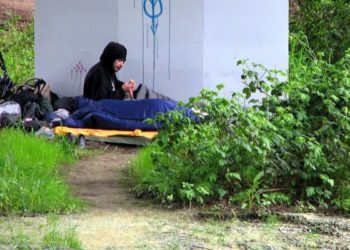“Housing First” linked to housing stability for homeless youth with mental illness
1. Over the course of 24 months, compared to youth receiving treatment as usual, homeless youth assigned to “Housing First” had increased housing stability.
2. Despite leading to greater housing stability, “Housing First” was not associated with significant quality of life improvements over controls.
Evidence Rating Level: 1 (Excellent)
Study Rundown: Homelessness is associated with many comorbid conditions including mental illness and poor education and presents a significant economic burden for society. One initiative aimed at reducing homelessness is “Housing First,” an approach that prioritizes immediate access to permanent, independent housing. Although increasing in popularity, its potential benefit, especially for homeless youth, is currently understudied. To investigate the impact of “Housing First” on housing stability in homeless youth with mental disabilities, researchers performed a subgroup analysis of individuals aged 18 to 24 years from the At Home/Chez Soi randomized controlled trial. Participants received either treatment as usual or were assigned to “Housing First” with additional support: assertive community treatment (ACT) or intensive case management (ICM) depending on the severity of their mental illnesses. After 24 months, results on the primary outcome, housing stability, suggested that those receiving “Housing First” were more often stably housed than those receiving treatment as usual. Although the “Housing First” group did score better on a metric of leisure at multiple time points throughout the study, the overall result over time was not significant. Interestingly, it was also found that employment was reduced in the “Housing First” group relative to the control group. Limitations of this study included its small sample size, reliance on self-reported data, and relatively short follow-up period. Continued research to address the most effective methods to reduce homelessness among youth will be critical for maximizing the opportunities of this vulnerable population and minimizing the financial burden for society.
Click to read the study, published today in Pediatrics
Relevant Reading: Can Housing First work for youth?
Study Author, Nicole Kozloff, MD talks to 2 Minute Medicine: Centre for Urban Health Solutions, Li Ka Shing Knowledge Institute, St. Michael’s Hospital, Toronto, Ontario, Canada.
“Despite the significant challenges for homeless youth with mental illness, there is little scientific evidence to guide the use of any specific interventions, particularly with respect to housing outcomes. Our study showed that Housing First can help homeless youth with mental illness maintain housing, and no less effectively than for older adults, what we believe to be a first step towards improving long-term trajectories for this vulnerable population.”
In-Depth [randomized controlled trial]: This subgroup analysis included 156 homeless or precariously housed 18 to 24 year olds with diagnosed mental illness across 5 cities in Canada. “Housing First” participants were provided with immediate access to housing and additional need-based support while treatment as usual participants had to rely on other community-based resources. The majority of data were collected by in-person interviews. Housing stability, the primary outcome of this study, was assessed by the Residential Time-Line Follow-Back Inventory, defined as the proportion of stably housed days out of days with reliable residence data over a period of 6 months. Generic quality of life in addition to exploratory outcomes including community functioning and use of health and criminal justice services were also investigated. Non-males comprised 44% of the “Housing First” group compared to 33% of the treatment as usual group. After adjusting for study city and ethnoracial and Aboriginal status, the mean difference in housing stability was 34%, with “Housing First” youth having stable housing for 65% of days with available data compared to 31% for the treatment as usual group (p < 0.001). These results were not significantly different than those obtained for adults > 24 years. Although “Housing First” youth reported significantly more leisure time at 6, 12, and 24 months (p < 0.05), the overall Treatment Group x Time interaction was not significant. A greater percentage of treatment as usual participants held at least one job over the 2-year study period compared to “Housing First” youth (44% v. 32%; adjusted odds ratio = 0.48, 95%CI: 0.24-0.99).
Image: CC/Wiki/Downtowngal
©2016 2 Minute Medicine, Inc. All rights reserved. No works may be reproduced without expressed written consent from 2 Minute Medicine, Inc. Inquire about licensing here. No article should be construed as medical advice and is not intended as such by the authors or by 2 Minute Medicine, Inc.







